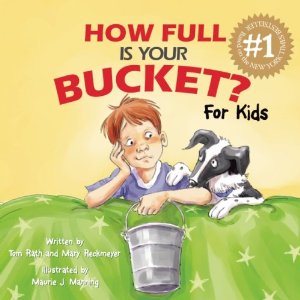One book I read in my pragmatics language group following a unit on feelings is the story How Full is Your Bucket? For Kids by Tom Rath and Mary Reckmeyer (see http://strengths.gallup.com/114595/Welcome-Bucketbook-com-Users.aspx for more information). This book demonstrates visually for children how we each feel and how our actions and words impact ourselves and each other. The premise is that we each have an invisible bucket, which has “water” added to it when words/actions make us feel better (so that we feel great when it’s full) and has “water” removed from it when words/actions make us feel worse (so that we feel the worst when it’s empty). The idea is to have the children begin to understand how their own feelings are impacted by the environment and others and to understand that their actions and words positively or negatively affect others. They also begin to learn that filling someone else’s bucket can fill their own bucket, too!
At home, use a small bucket or other container (maybe a plastic cup) for each family member. Keep a stash of small objects nearby to use to fill them, such as pompoms, cotton balls, paper water droplets, or marbles. Add and remove them throughout the day, or start with just an activity like a family board game or dinner. It may help initially to draw or attach a face representing the feeling for each level of the bucket (ex: very sad/crying face at the bottom, an “o.k.” face in the middle, and a very happy face at the top).
Consider pairing this with looking at books on feelings or pictures in magazines or story books to identify whether each person is having water added to or removed from his/her bucket. Initially, you can comment on them, and then begin to help your child identify them. As your child gets good at identifying whether the actions/words are resulting in added or removed water, you can talk quantitatively about the amount of water that might be added or removed. For instance, a little water might be removed when someone gently bumps a person (something that’s a little deal), but a lot of water would be removed when a child’s favorite toy has broken (something that is a big deal).
* As always, discuss this information with your child’s SLP for information on its relevancy and any appropriate accommodations to his/her communication needs.
By Mary Jane Fledderjohn, MS, CCC-SLP/L


 CAIU (Capital Area Intermediate Unit)
CAIU (Capital Area Intermediate Unit)